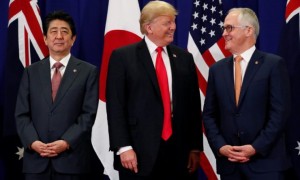
Quadrilateral grouping
-
The Quadrilateral Security Dialogue (QSD) was an informal strategic dialogue between the United States, Japan, Australia and India that was maintained by talks between member countries.
-
The dialogue was initiated in 2007 by Prime Minister Shinzo Abe of Japan, with the support of Vice President Dick Cheney of the US, Prime Minister John Howard of Australia and Prime Minister Manmohan Singh of India.
-
Japan President Shinzo Abe delivered a speech to the Indian Parliament in August 2007, entitled a “confluence of the two seas”, a phrase he took from the title of a book written by Mughal prince Dara Shikoh.
-
The dialogue was paralleled by joint military exercises of an unprecedented scale, titled Exercise Malabar.
-
The diplomatic and military arrangement was widely viewed as a response to increased Chinese economic and military power, and the Chinese government responded to the Quadrilateral dialogue by issuing formal diplomatic protests to its members.
What was the intention?
-
The initiation of an American, Japanese, Australian and Indian defense arrangement, modeled on the concept of a Democratic Peace
-
The Quadrilateral was supposed to establish an “Asian Arc of Democracy,” envisioned to ultimately include countries in central Asia, Mongolia, the Korean peninsula, and other countries in Southeast Asia: “virtually all the countries on China’s periphery, except for China itself.”
What is China’s response?
-
China has hoped that a US-brokered quadrilateral meet that includes India, Japan and Australia is not aimed at China and would “comply with the trend of times” which it identified as peace, development, and cooperation.
-
The Chinese Foreign Ministry said it has noted the development and hopes that such an arrangement will promote mutual trust among countries in the region and not harm Beijing’s interests.
Drawbacks
-
The Quadrilateral was viewed as an “Asian NATO;”
-
Daniel Twining of the German Marshall Fund of the United States has written that the arrangement “could lead to military conflict,” or could instead “lay an enduring foundation for peace” if China becomes a democratic leader in Asia.
India’s stand towards Pacific diplomacy:
-
New Delhi does not consider the newly re-established quadrilateral format of U.S.-Japan-India-Australia a part of its Indo-Pacific region policy.
-
India would like to engage more closely with Russia in the Indo-Pacific region as well.
-
India’s maritime partnerships would not be restricted to the Quad formation with the U.S. and its allies.
-
The Quadrilateral format of U.S.-Japan-India-Australia is one of the many multilateral dialogues in the region, and not directed against any country.
-
Given improved relations with China in the last few months, the government has been seen as less active in promoting the Quad, also declining a request from Australia to join the ongoing Malabar naval exercises with the other three Quad members.
Source: